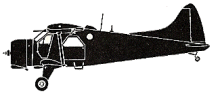
ASN Wikibase Occurrence # 207274
This information is added by users of ASN. Neither ASN nor the Flight Safety Foundation are responsible for the completeness or correctness of this information.
If you feel this information is incomplete or incorrect, you can submit corrected information.
| Date: | Sunday 25 July 1993 |
| Time: | 10:00 |
| Type: |  de Havilland Canada DHC-2 Beaver |
| Owner/operator: | |
| Registration: | VH-XHJ |
| MSN: | 1040 |
| Year of manufacture: | 1957 |
| Fatalities: | Fatalities: 0 / Occupants: |
| Aircraft damage: | Minor |
| Location: | Hamilton Island, QLD -
 Australia Australia
|
| Phase: | Landing |
| Nature: | Passenger - Non-Scheduled/charter/Air Taxi |
| Departure airport: | Hayman Island, QLD |
| Hamilton Island, QLD | |
| Investigating agency: | BASI |
| Confidence Rating: |
The aircraft was engaged on a passenger charter flight to Hayman and Hamilton Islands. The first flight from Shute Harbour to Hayman Island was without incident and the aircraft carried out a water landing. The landing gear was then extended and the aircraft taxiied via the boat ramp to the terminal area. After boarding a passenger, the pilot taxied the aircraft back onto the water and retracted the landing gear. At this stage, he noted that the aircraft electrical system voltage indication was low and that there was no charge rate indicated. He decided to take off and fly to Hamilton Island and land on the runway. Hamilton Island is the maintenance facility for the operator. Approaching Hamilton Island, the pilot attempted to make radio contact with the company but received no reply. The Hamilton Island Control Tower was not manned as it was outside its hours of operation. The pilot was unable to ascertain the position of the landing gear as the normal position indicators were not illuminated. He decided to overfly the runway at low level to gain the attention of company ground staff so that they could check the position of the landing gear. There were rain showers and high humidity in the area and the pilot experienced difficulty in observing the gear position via the wingtip-mounted mirrors. The ground staff blocked the runway with a vehicle, signalled with a red light from the control tower and waved their arms in a fashion which the pilot took to be an indication that he should not land on the runway but alight on the water. However, the signals were meant to convey the message that the landing gear was not fully extended. After briefing the passengers to put on their life jackets and adjust their seat belts, the pilot made an approach to the water to the north of the runway. The approach was normal but immediately after touchdown the aircraft nosed over and floated inverted in a nose-down attitude. The pilot escaped from the aircraft, which was filling with water, and then assisted the passengers to escape. They were all rescued uninjured by watercraft. When the aircraft was recovered, it was found that all the wheels were locked in the up position except the left mainwheel which was partially up. Subsequent testing of the landing gear system could not find any fault in the hydraulic-powered extension/retraction system. The electrical failure was traced to a faulty transistor in the voltage regulator. The manual hydraulic landing gear extension system is activated by selecting the gear down with the normal lever and then operating a handle to pump down the four legs of the gear. The action of the lever is light and, when the gear is down, the lever is difficult to move. The position is then checked in the mirrors and by observing the left nosewheel position from the cockpit through the side window. It is considered probable that on this occasion, the pilot, having initially failed to fully extend the gear, selected the gear position lever to the up position and continued pumping, while never achieving a fully up position on all gear legs. The pilot was experienced on the aircraft type and had completed the required company flight checks. However, his last check on this aircraft type was six months previously, and that check did not include the operation of the emergency gear extension system.
SIGNIFICANT FACTORS
1. The voltage regulator suffered an internal failure which resulted in the battery failing and no electrical power being available to the aircraft.
2. The weather conditions resulted in the cabin windows fogging, making observation of the landing gear position mirrors difficult.
3. The pilot was not adequately familiar with the operation of the emergency landing gear extension system.
4. The signals given to the pilot were misinterpreted as an instruction to alight on the water.
Accident investigation:
 |
|
Sources:
https://www.atsb.gov.au/publications/investigation_reports/1993/aair/199302213/
https://www.atsb.gov.au/media/5227573/199302213.pdf
Revision history:
| Date/time | Contributor | Updates |
|---|---|---|
| 10-Mar-2018 08:03 | Pineapple | Added |
Corrections or additions? ... Edit this accident description
The Aviation Safety Network is an exclusive service provided by:


 ©2024 Flight Safety Foundation
©2024 Flight Safety Foundation